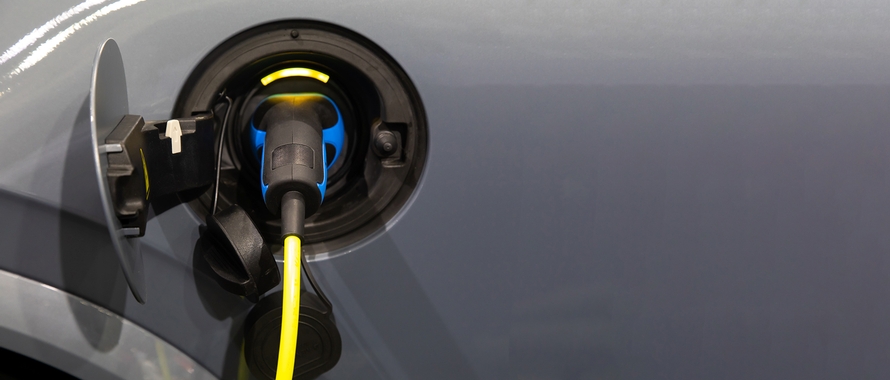Traveling Tech
Learn how your co-op can help you make informed decisions about electric vehicles

Brianna Wall has never been skittish to try something new. When the opportunity came to purchase a Ford Mustang Mach-E electric vehicle (EV) from her hometown in Stigler, Oklahoma, she put her name on the waiting list as fast as the horse the car is named after.
Wall, the editor and creative director for Oklahoma Electric Cooperative, had driven the cooperative’s Chevy Bolt EV previously and knew she was a fan of the immediate power and response EVs could offer. Wall’s Mustang features all-wheel drive and an extended battery range of up to 300 miles.
“What I need a vehicle for—driving to and from work and my son’s school, plus the occasional longer trip—an EV is a perfect fit,” Wall says. “We save on gas and have the convenience of charging in our own garage.”
When drivers do need to go the distance, Oklahoma boasts one of the most robust statewide EV public charging networks in the nation, thanks to a strategic partnership between Oklahoma’s electric cooperatives and Francis Energy. Approximately every 50 miles there is a charger within the state. As of October 2020, there are 114 charging stations or sites that consist of 360 total chargers.
Global companies are even taking note. Tulsa, Oklahoma, is among only 16 locations where Amazon will be using EVs for deliveries in 2021. On the consumer scale, drivers who live in rural areas reported driving an average of 13,029 miles annually, which is significantly more than drivers who live in cities or towns, according to the AAA Foundation for Traffic Safety American Driving Survey. Having access to public charging stations brings peace of mind for longer trips, but the true savings come into play when consumer-members charge in the comfort of their own home.
“From the consumer-member’s perspective, it’s a new means of transportation and a means by which they can experience savings driving the same number of miles on a monthly basis,” Mark Faulkenberry, Western Farmers Electric Cooperative (WFEC) vice president of marketing and member relations, says.
The key, according to Faulkenberry, is to ensure those vehicles are charging at the right time. From the utilities’ perspective, charging during non-peak hours determined by local electric cooperatives has the potential to lower the energy cost for all rate payers and takes the upward pressure off rates into the future. A high percentage of the energy sold at night for WFEC member systems is renewable, which means EV owners are going green during the day by lowering emissions and going green overnight by using renewable energy.
“Your co-op should be the first call you make when considering to purchase an EV,” Faulkenberry says. “They are trusted advisers who will be able to educate you on charging types and potential rebates and incentives.”
There are many decisions to make when considering purchasing an EV, including a plan on how to charge it regularly. Charging station rebates are offered by Associated Electric Cooperative, a generation and transmission cooperative that provides electricity to six regional G&T cooperatives, including KAMO Power. KAMO in turn serves 17 member distribution cooperatives in northeast Oklahoma and southwest Missouri.
“Members of the 51 distribution cooperatives served by the Associated Electric Cooperative system may be eligible for a $250 charging station rebate through the Take Control & Save energy efficiency program,” says Scott Blue, Energy Services Specialist with Associated Electric Cooperative. “Of course, members should check with their local electric cooperative before purchasing and installing a charging station to determine if they qualify for the rebate.”

There are three major categories of chargers, based on the amount of power the charger can provide. The rebate mentioned above is for Level 2 chargers.
Level 1 is the easiest charging option for an EV and consists of plugging the car into a standard 120-volt outlet. This method will add five miles of charge per hour.
Level 2 stations require a 240-volt plug and a dedicated 40-amp circuit. They will provide between 10 and 25 miles of range for each hour of charging, which would fully charge the battery overnight. Timers can also be used to charge the vehicle in the middle of the night when electric consumption is typically lower. These chargers must be installed by a certified electrician and will generally cost between $500-$1,200 to install.
Level 3 is the fastest form of charging and requires specialized equipment more suited to public charging stations. This high-speed technique should only be used for long-distance driving, since it can degrade the battery over time.
WFEC currently has seven EVs in its company fleet with plans to increase as more makes and models become available—they have a special interest with upcoming release of an electric pickup. Employees can use the cars for work travel less than 175 miles roundtrip, but within the next year or two that range will be expanding with testing the charging network across the state. Faulkenberry says the cooperative has saved 83% in fuel costs from the fleet alone.
The cost to purchase an EV is also dropping. In addition, the average lifetime cost of ownership for an EV priced under $50,000 is $6,000-$10,000 less than internal combustion engine vehicles, according to Consumer Reports. The main parts needing maintenance in an EV are windshield wipers, wiper fluid, and tires.
Overall savings will vary based on vehicle type, driving habits, and weather conditions. To find out if an EV is right for you, visit the Choose EV Oklahoma website.
The More You Know
Want to estimate the potential savings between gas and EV?
The Choose EV Oklahoma website offers simple cost-saving calculators to help estimate savings between gas and electric vehicles. Adjust data fields for your scenario and see instant comparisons between the two for Oklahoma.
Have an EV and planning a trip? Be sure to plan ahead!
Apps like PlugShare, EVmatch, and Open Charge Map can show locations based on plug type and charging speed.
Looking for more information?
Watch WFEC’s six-part video series developed to help inform consumers on EVs by visiting the Western Farmers Electric Cooperative videos page.
Sign up for our Oklahoma Living Newsletter


